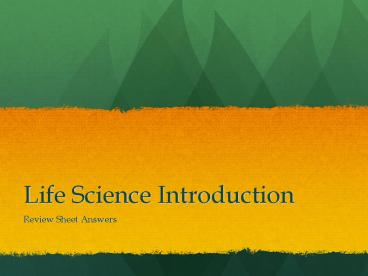Life Science Introduction - PowerPoint PPT Presentation
Title:
Life Science Introduction
Description:
Life Science Introduction Review Sheet Answers 1. How did Louis Pasteur s experiment disprove the idea of spontaneous generation? The broth that had been boiled did ... – PowerPoint PPT presentation
Number of Views:90
Avg rating:3.0/5.0
Title: Life Science Introduction
1
Life Science Introduction
- Review Sheet Answers
2
1. How did Louis Pasteurs experiment disprove
the idea of spontaneous generation?
- The broth that had been boiled did not have
bacteria. This proved that bacteria only grew
from existing bacteria.
3
2. What are the 6 characteristics of living
things?
- Cellular Organization
- Similar Chemicals
- Energy Use
- Growth and Development
- Response to Surroundings
- Reproduction
4
3. 4 Basic Needs of All living Things
- Energy
- Water
- Living Space
- Stable Internal Conditions
5
4. What is the difference between growth and
development?
- Grow Get bigger
- Develop Change into something different
6
5. What is the difference between an autotroph
and a heterotroph?
- Auto make their own food
- Hetero Cannot make their own food
7
6. Give an example of a stimulus and response.
- Answers will vary.
- Stimulus Bright Light
- Response Squinting Eyes
- Stimulus The heat is on inside a building
- Response You take your winter coat off.
8
Microscopes1. What is the difference between a
compound and simple microscope?
- Compound 2 lenses
- Simple 1 lens
9
2. What did Robert Hooke discover with the
microscope?
- Cells
10
3. When you carry the microscope, where should
you place your hands?
- One on the arm, and one on the base.
11
4. When you turn the microscope off, which
objective lens should be directly above the stage?
- Low
12
5. Always start focusing your microscope with
which objective lens?
- Low power
13
6. When focusing on medium and high powers, you
can only use which adjustment knob?
- Fine
14
Abiotic/Biotic1. Define biotic and give an
example.
- Living or was once living
- Wooden Desk
15
2. Define abiotic and give an example.
- Never, ever living.
- Rock or mineral
16
3. If you are looking under the microscope, what
would you see in a biotic sample?
- Cells
17
Cell Parts and Functions
18
Cell Wall
- Rigid layer of non-living material that surrounds
the cell - Plant and Bacteria
19
Cell Membrane
- Controls what substances enter and leave the
cell. It also offers protection. - All cell types
20
Lysosomes
- Contains chemicals that break down large food
particles into smaller ones. - Animal Cells (your book also says some plant)
21
Golgi Apparatus (or body)
- The mailroom
- This part receives proteins and other newly
formed materials from the ER, packages them, and
distributes them to other parts of the cell. - Plant and Animal Cells
22
Nucleus
- The Cells control center.
- It directs all of the cells activities
- Plant and animal cells
23
Nucleolus
- Makes ribosomes
- Plant and animal cells
24
Chromatin
- Genetic material or instructions that direct the
functions of the cell - Plant and animal
25
Ribosomes
- Factories that produce proteins
- All cell types
26
Endoplasmic Reticulum (ER)
- A series of passageways that carry proteins and
other materials from one part of the cell to
another - Plant and Animal
27
Cytoplasm
- Region between the cell membrane and the nucleus.
Many organelles are found here. - All Cells
28
Vacuole
- The storage are of the cell
- Plant (your book has it that they are also in
plants we will talk about this discrepancy)
29
Chloroplasts
- Capture energy from sunlight and use it to
produce energy for the cell. - Plant cells
30
Mitochondria
- Mighty Mitochondria
- Produces most of the cells energy
- Plant and animal cells
31
Nuclear Membrane
- Protects the nucleus and controls what goes into
and out of it. - Plant and Animal Cells
32
Vesicle
- Portions of the ER break off to form small
packages called vesicles. Vesicles transport
processed materials to the golgi body. - Plant and Animal
33
Organelle
- Tiny cell structures that carry out specific
functions. - All cell types































